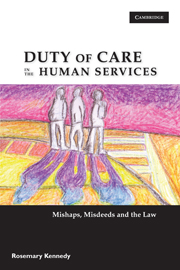Book contents
- Frontmatter
- Dedication
- Contents
- Acknowledgements
- Author's note
- Part 1 Positioning and mapping the territory of human service mishaps and misdeeds
- Part 2 Mishaps and misdeeds through a law lens
- Part 3 Mishaps and misdeeds through a human services lens
- Chapter 9 Service delivery – screening, assessment and planning
- Chapter 10 Service delivery – implementation and closure
- Chapter 11 Information and records management
- Chapter 12 Relationships, rifts and reactions
- Part 4 Mishaps and misdeeds through a unified lens
- Appendix: Finding the law and cases
- References
- Index
Chapter 12 - Relationships, rifts and reactions
from Part 3 - Mishaps and misdeeds through a human services lens
Published online by Cambridge University Press: 05 June 2012
- Frontmatter
- Dedication
- Contents
- Acknowledgements
- Author's note
- Part 1 Positioning and mapping the territory of human service mishaps and misdeeds
- Part 2 Mishaps and misdeeds through a law lens
- Part 3 Mishaps and misdeeds through a human services lens
- Chapter 9 Service delivery – screening, assessment and planning
- Chapter 10 Service delivery – implementation and closure
- Chapter 11 Information and records management
- Chapter 12 Relationships, rifts and reactions
- Part 4 Mishaps and misdeeds through a unified lens
- Appendix: Finding the law and cases
- References
- Index
Summary
RELATIONSHIPS ARE THE bedrock of the human services. They are both the content of human services work and the vehicle through which most of it is conducted. Many human services relationships, particularly those with clients, come into existence because of distress, dislocation and disarray and involve high levels of emotion. As Camilleri (1996 p. 80) says in his elucidation of emotional labour, ‘the work of social work is the managing, displaying and controlling of emotions and feelings…’. Many human services relationships are centred on sensitive personal matters and are realised in intimate environments, such as private offices, homes or residential facilities. Many of the relationships will, by virtue of the nature of human services work, occur in circumstances in which diversity, difference and vulnerability are significant. Many of them involve or invoke strong beliefs about rights, morality and justice. Many also expose or aggravate discord about intervention methods and practices, and program and organisational arrangements. Strong feelings, disparate expectations, capacities and passions, alone or in combination, can distort, fracture and stunt relationships. On the other hand, emotional intensity, intimacy and power imbalances can fertilise inappropriate relationships. Both relationships that sour, and those that flourish too vigorously, might attract the attention of the law.
Specht's (1985 p. 226) schema of social workers' interpersonal interactions is a useful starting place for thinking about the range of people involved in mainstream human services relationships.
- Type
- Chapter
- Information
- Duty of Care in the Human ServicesMishaps, Misdeeds and the Law, pp. 234 - 246Publisher: Cambridge University PressPrint publication year: 2009



